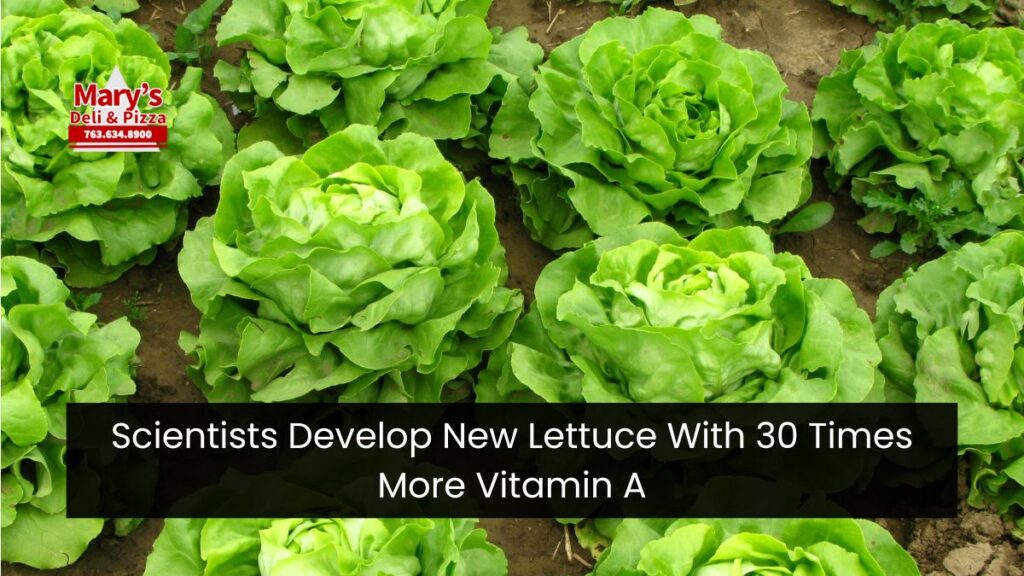A groundbreaking discovery in the world of nutrition has just been made, as scientists from Spain’s Universitat Politècnica de València (UPV) have developed a new variety of lettuce with 30 times more vitamin A than traditional varieties.
This vitamin-packed vegetable could be a game-changer in the fight against global micronutrient deficiencies, offering an affordable and accessible way to improve health worldwide.
Addressing Global Micronutrient Deficiency
Micronutrient deficiency, also known as “hidden hunger,” remains a pressing issue in many countries. Vitamin A deficiency is particularly concerning, as it can lead to severe health problems, including xerophthalmia (a condition that can cause blindness) and other life-threatening issues. It primarily affects children in malnourished populations globally.
Food fortification and dietary supplementation are often recommended to combat this deficiency, but these strategies can be too costly for many communities.
To address this, the researchers at UPV sought to develop a more cost-effective and sustainable solution. Their answer? A new method of “biofortification” that enhances the nutrient content of green leafy vegetables.

Biofortification and the Role of Beta-Carotene
The key to this new lettuce lies in the biofortification process, where the researchers were able to increase “pro-vitamin A carotenoids,” specifically beta-carotene, which is a precursor to vitamin A.
By storing high levels of beta-carotene in tiny particles known as “plastoglobules” (lipoprotein particles made of protein and fat) within the lettuce leaves, they were able to achieve an astonishing 30-fold increase in vitamin A content compared to untreated leaves.
These plastoglobules, typically found in tobacco plants and lettuce, do not participate in photosynthesis and do not usually store carotenoids.
However, with advanced molecular techniques and intense light treatments, the researchers successfully stimulated the formation of these plastoglobules to hold beta-carotene. The result? Lettuce with significantly enhanced vitamin A levels that maintain its natural taste and scent.
Boosting Bioaccessibility
In addition to increasing the nutrient content, the research team also focused on enhancing the bioaccessibility of the nutrients.
This means making it easier for the human body to absorb the beta-carotene from the lettuce. As first author Luca Morelli explained, the new biofortified lettuce allows for better absorption of vitamin A during digestion, ensuring that the added nutrients are fully utilized by the body.

Potential for Future Applications
The research team’s discovery has the potential to revolutionize the nutrition of not just lettuce, but other green leafy vegetables such as spinach and chard.
The scientists believe that by using similar biofortification techniques, a range of vegetables could be enhanced with higher levels of essential vitamins without altering their characteristic flavor and aroma. This breakthrough could have far-reaching implications for improving global nutrition and food security.
Table: Key Facts About the New Vitamin A-Packed Lettuce
| Aspect | Details |
|---|---|
| Vitamin A Increase | 30-fold increase in beta-carotene compared to regular lettuce |
| Key Technique | Biofortification using plastoglobules to store high levels of beta-carotene |
| Vegetables Used | Lettuce (with potential applications for spinach, chard, and others) |
| Bioaccessibility | Enhanced bioaccessibility of beta-carotene for easier absorption in the body |
| Benefits | Tackles micronutrient deficiencies, particularly vitamin A deficiency |
| Flavor and Scent | No alteration in the natural taste or aroma of the biofortified lettuce |
The Bottom Line
This new vitamin A-packed lettuce represents a significant advancement in the battle against micronutrient deficiency, providing a practical and affordable solution to improve global health.
By utilizing biofortification techniques, researchers have developed a vegetable that retains its taste while delivering vastly improved nutritional benefits. As the world faces challenges in food security, these scientific innovations offer hope for a healthier future.
FAQs
1. What is biofortification?
Biofortification is the process of increasing the nutrient content of crops through advanced techniques, such as molecular biology.
2. How much more vitamin A does this new lettuce have?
The new lettuce has 30 times more vitamin A compared to traditional varieties, thanks to its increased beta-carotene content.
3. What are plastoglobules?
Plastoglobules are lipoprotein particles made of protein and fat, used by the researchers to store beta-carotene in the lettuce.
4. Does this biofortified lettuce taste different?
No, the biofortified lettuce retains its natural taste and aroma while delivering enhanced nutritional benefits.
5. How can this new lettuce help global health?
This vitamin-rich lettuce can help combat micronutrient deficiencies, particularly vitamin A deficiency, which affects millions worldwide.






